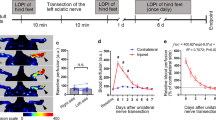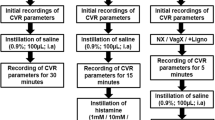Summary
-
1.
The cutaneous vasodilation following arterial occulusion (“reactive hyperemia”) was studied in the rat hind paw. A peak increase in venous outflow of 200–250% was observed within 1 min after a 3 min occlusion period.
-
2.
Chronic denervation as well as capsaicin pretreatment reduced the postocclusive cutaneous vasodilatation by more than 60% (P<0.01). This demonstrates that the reactive vasodilatation is of neurogenic origin and mediated by small diameter afferent fibres.
-
3.
Reduction of the postocclusive cutaneous vasodilatation after histamine depletion by compound 48/80 indicates the involvement of histamine.
-
4.
Among all neuropeptides known to occur in primary sensory neurones only substance P and vasoactive intestinal polypeptide cause vasodilatation when infused i.a. into the rat paw. In contrast to antidromic sensory nerve stimulation or i.a. substance P infusion, vasoactive intestinal polypeptide does not cause plasma extravasation. The vasodilator potency of vasoactive intestinal polypeptide is about 1/500 of substance P in the rat paw. Therefore only substance P is able to mimic the reactive vasodilatation.
-
5.
It is concluded that the postocclusive cutaneous vasodilatation is caused mainly by the release of substance P from peripheral endings of small diameter nerve fibres. The “axon reflex”, also involving neurogenic vasodilatation, is assumed to be exerted by the same mechanism.
Similar content being viewed by others
References
Arvier PT, Chahl LA, Ladd RJ (1977) Modification by capsaicin and compound 48/80 of dye leakage induced by irritants in the rat. Br J Pharmacol 59:61–68
Bayliss WM (1901) On the origin from the spinal cord of the vasodilator fibres of the hind limb, and on the nature of these fibres. J Physiol (Lond) 26:173–209
Bill A, Stjernschantz J, Mandahl A, Brodin E, Nilsson G (1979) Substance P: release on trigeminal nerve stimulation, effects in the eye. Acta Physiol Scand 106:371–373
Breslauer F (1919) Die Pathogenese der trophischen Gewebsschäden nach der Nervenverletzung. Dtsch Z Chir 150:50–81
Brodin E, Gazelius B, Lundberg JM, Olgart L (1981) Substance P in trigeminal nerve endings: Occurrence and release. Acta Physiol Scand (in press)
Burnstock G (1977) Autonomic neuroeffector junctions-reflex vasodilatation of the skin. J Invest Dermatol 69:47–57
Burnstock G (1978) An assessment of purinergic nerve involvement in vasodilatation. In: Vanhoutte PM, Leusen J (eds) Mechanisms of vasodilatation, S. Karger. Basel New York, pp. 278–284
Chahl LA (1979) The effect of putative peptide neurotransmitters on cutaneous vascular permeability in the rat. Naunyn-Schmiedeberg's Arch Pharmacol 309:159–163
Chahl LA, Manley SW (1980) Inflammatory peptide in spinal cord: evidence that the mediator of antidromic vasodilatation is not substance P. Neurosci Lett 18:99–103
Chan-Palay V, Palay SL (1977) Immunocytochemical identification of substance P cells and their processes in rat sensory ganglia and their terminals in the spinal cord: light microscopic studies. Proc Natl Acad Sci USA 8:3597–3601
Chapman LF, Goodell H (1964) The participation of the nervous system in the inflammatory reaction. Ann NY Acad Sci 116:990–1017
Carraway R, Leeman SE (1973) The isolation of a new hypotensive peptide, neurotensin, from bovine hypothalami. J Biol Chem 248:6854–6861
Celander O, Folkow B (1953a) The nature and the distribution of afferent fibres provided with the axon relfex arrangement. Acta Physiol Scand 29:359–370
Celander O, Folkow B (1953b) The correlation between the stimulation frequency and the dilator response evoked by “antidromic” excitation of the thin afferent fibres in the dorsal roots. Acta Physiol Scand 29:371–376
Cooper IS (1950) A neurologic evaluation of the cutaneous histamine reaction. J Clin Invest 29:465–469
Cuello AC, DelFiacco M, Paxinos G (1978) The central and peripheral ends of the substance P-containing sensory neurones in the rat trigeminal system. Brain Res 152:499–509
Duling BR (1978) Oxygen, carbon dioxide, and hydrogen ion as local factors causing vasodilatation. In: Vankoutte PM, Leusen J (eds) Mechanisms of vasodilatation, S Karger, Basel New York, pp 193–199
Frumin MJ, Ngai SH, Wang SC (1953) Evaluation of vasodilator mechanisms in the canine hind leg; question of dorsal root participation. Am J Physiol 173:428–436
Gamse R, Holzer P, Lembeck F (1980a) Decrease of substance P in primary afferent neurones and impairment of neurogenic plasma extravasation by capsaicin. Br J Pharmacol 68:207–213
Gamse R, Leeman SE, Holzer P, Lembeck F (1980b) Effect of capsaicin on the content of somatostatin, substance P and neurotensin in the central and peripheral nervous system of the rat. In: Brzin M, Sket D, Bachelard H (eds) Synaptic constitutents in health and disease, Mladinska knjiga-Pergamon Press, Yugoslavia, Ljubljana, p 275
Gazelius B, Olgart L (1980) Vasodilatation in the dental pulp produced by electrical stimulation of the inferior alveolar nerve in the cat. Acta Physiol Scand 108:181–186
Hökfelt T, Elde R, Johansson O, Luft R, Nilsson G, Arimura A (1976) Immunohistochemical evidence for separate populations of somatostatin-containing and substance P-containing primary afferent neurons in the rat. Neuroscience 1:131–136
Hökfelt T, Kellerth IO, Nilsson G, Pernow B (1975) Experimental immunohistochemical studies on the localization and distribution of substance P in cat primary sensory neurons. Brain Res 100:235–252
Holzer P, Jurna J, Gamse R, Lembeck F (1979) Nociceptive threshold after neonatal capsaicin treatment. Eur J Pharmacol 58:511–514
Jancsó G, Király E, Jancsó-Gábor A (1977) Pharmacologically induced selective degeneration of chemosensitive primary sensory neurones. Nature 270:741–743
Jancsó G, Király E, Jancsó-Gábor A (1980) Chemosensitive pain fibres and inflammation. Int J Tiss Reac II, 57–66
Jancsó N, Jancsó-Gábor A, Szolcsányi J (1967) Direct evidence for neurogenic inflammation and its prevention by denervation and by pretreatment with capsaicin. Br J Pharmacol Chemother 31:138–151
Johnson AR, Erdös EG (1973) Release of histamine from mast cells by vasoactive peptides. Proc Soc Exp Biol Med 142:1253–1256
Juan H, Lembeck F (1974) Action of peptides and other algesic agents on paravascular pain receptors of the isolated perfused rabbit ear. Naunyn-Schmiedeberg's Arch Pharmacol 283:151–164
Juan H, Sametz W (1980) Histamine-induced release of arachidonic and of prostaglandins in the peripheral vascular bed: Mode of action. Naunyn-Schmiedeberg's Arch Pharmacol 314:183–190
Kiernan JA (1972) The involvement of mast cells in vasodilatation due to axon reflexes in injured skin. Quart J Exp Physiol 57:311–317
Kiernan JA (1976) Evidence for the involvement of vasoactive constituents of mast cells in axon reflex vasodilatation in the skin of the rat. Derm Res 255:1–8
Lembeck F, Holzer P (1979) Substance P as neurogenic mediator of antidromic vasodilation and neurogenic plasma extravasation. Naunyn-Schmiedeberg's Arch Pharmacol 310:175–183
Lembeck F, Starke K (1963) Substance P content and effect of capillary permeability of extract of various parts of human brain. Nature 199:1295–1296
Lembeck F, Gamse R, Juan H (1977) Substance P and sensory nerve endings. In: von Euler US, Pernow B (eds) Substance P, Raven Press, New York, pp 169–181
Lewis T, Marvin HM (1927) Observations relating to vasodilatation arising from antidromic impulses, to Herpes Zoster and trophic effects. Heart 14:27–46
Lundberg JM, Hökfelt T, Nilsson G, Terenius L, Rehfeld J, Elde R, Said S (1978) Peptide neurons in the vagus, splanchnic and sciatic nerves. Acta Physiol Scand 104:499–501
Olgart L, Hökfelt T, Nilsson G, Pernow B (1977a) Localisation of substance P-like immunoreactivity in nerves in the tooth pulp. Pain 4:153–159
Olgart L, Gazelius B, Brodin E, Nilsson G (1977b) Release of substance P-like immunoreactivity from the dental pulp. Acta Physiol Scand 101:510–512
Patterson GC (1956) Role of extra vascular pressure in the causation of reactive hyperemia in the human forearm. Clin Sci 15:17–25
Raulino-Filho M, Garcia Leme J (1977) Participation of sensory nervous structures in the development of inflammatory reactions. Br J Exp Pathol 58:124–129
Reed WB, Pidgeon J, Becker SW (1961) Studies on the triple response of Lewis in patients with spinal cord injury. J Invest Dermatol 37:135–143
Rehfeld JF, Goltermann N, Larsson LI, Emson PM, Lee CM (1979) Gastrin and cholecystokinin in central and peripheral neurons. Fed Proc 38:2325–2329
Rosell S, Olgart L, Gazelius B, Panopoulos P, Folkers K, Hörig J (1981) Inhibition of antidromic and substance P-induced vasodilatation by a substance P antagonist. Acta Physiol Scand (in press)
Scadding JW (1980) The permanent anatomical effects of neonatal capsaicin on somatosensory nerves. J Anat 131:473–484
Seybold V, Elde R (1980) Immunohistochemical studies of peptidergic neurons in the dorsal horn of the spinal cord. J Histochem Cytochem 28:367–370
Sonnenschein RR, Bernstein M (1957) Relation to the central nervous system of neural pathways mediating histamine flare and nicotine sweating. J Appl Physiol 11:481–485
Stach W (1961) Morphologische Beziehungen zwischen Mastzellen und vegetativer Endformation. Zeitschr Mikr Anat Forschung 67:257–280
Starke K (1964) Substanz P-Gehalt und permeabilitätserhöhende Wirkung in verschiedenen Gehirngebieten. Naunyn-Schmiedeberg's Arch Exp Path u Pharmak 247:149–163
Vanhoutte PM, Leusen I (1978) Mechanism of vasodilatation Karger, Basel New York
Willems JL, Bogaert MG (1978) Neurogenic vasodilatation. Gen Pharmacol 9:223–227
Author information
Authors and Affiliations
Rights and permissions
About this article
Cite this article
Lembeck, F., Donnerer, J. Postocclusive cutaneous vasodilatation mediated by substance P. Naunyn-Schmiedeberg's Arch. Pharmacol. 316, 165–171 (1981). https://doi.org/10.1007/BF00505312
Received:
Accepted:
Issue Date:
DOI: https://doi.org/10.1007/BF00505312




